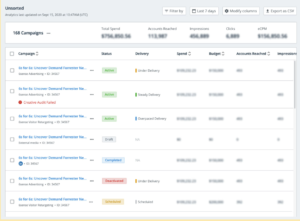Sometimes launching a marketing campaign can feel a bit like throwing darts. You see the numbers on the board and know where you want to aim — but execution is everything. You aim for the bullseye, but might end up hitting the wall.
There’s lots of reasons why campaigns miss the mark. Maybe the audience wasn’t the right target, the channel wasn’t the most effective, or the messaging didn’t resonate. Given how much planning, time, and money can go into a campaign, a dud might set you back an entire quarter.
However, there are better ways to plan and execute on marketing campaigns. There are tools that help pinpoint your audience and deliver the right message in the right channel, all but guaranteeing good results.
Here’s how to build marketing campaigns that’ll hit the mark.
Step 1: Choose the Right Audience with Real-Time Data Slices
Traditionally, marketers have relied on static lists to build campaign audiences. The audience in these lists could be based on region, title, industry, target account lists, or any other data point.
The one thing these static lists have in common is that they get old and out of date very quickly. You’re aiming at targets that, quite often, are no longer there thanks to employee turnover and organizational changes in your target accounts.
Here’s a better way: Build your campaigns using dynamic segments. Rather than relying on static data, your marketing teams should leverage real-time data.
A platform like 6sense gives users an immense set of filters and data they can use to build a campaign. For instance, here’s a look at how you could target a “competitor takeaway” campaign — going after accounts that are at the end of their contract with one of your competitors:

An example of a segment of accounts with a competitor contract expiring in 90 days.Custom filters tap into your Customer Data Platform, with its always up-to-date customer intel. These filters help you quickly define specific audience segments to power hyper-relevant campaigns.
Your marketing team is a creative bunch. When you hand out these dynamic segments to make campaigns, you’ll unleash that creativity.
Step 2: Reach your Audience in the Right Place
Marketers love email. It’s easy to use, relatively cheap, and can reach a huge audience very quickly. But your buyers aren’t necessarily waiting with bated breath for your emails to land into their inboxes. They’re busy doing other stuff like:
- For starters, their jobs
- Reading industry news
- Researching solutions that can solve their problems
- And more
With that in mind, your campaign should reach buyers in the place your messaging is most likely to resonate. For instance, it might be more effective to run ads on a site you know your buyers are reading, since it’s a more relevant channel for catching their attention.
Or, maybe you know your buyers are big LinkedIn users and you have great creative for a Sponsored Post to stop them dead in their scrolling.
Email is also a useful channel that can drive real results (one study found email marketing returns $36 for every $1 spent) but when you’re building a marketing campaign, you need to understand your target audience’s habits.
By incorporating data on their content consumption and buying journey stage, you can be sure you’re reaching them in the right channel.

Step 3: Tailor the Messaging — and Experience — for the Audience
If you have the right audience and the perfect channel lined up, there’s still one enormous part of any marketing campaign to master: messaging.
To make sure your marketing campaign resonates with your target audience, you must combine your internal knowledge about your value drivers with real-life data about the topics your target audience cares about.
Uncovering those topics requires discovering your buyers’ online research and activity. We call this the Dark Funnel™ because most of that activity occurs anonymously.
When you know what your buyers are researching, the channels they’re using, and the content they’re engaging with, you can tailor your messaging much more precisely.
And you can deliver personalized experiences thanks to the time you invested building dynamic segments. 80% of buyers say they’re more likely to buy from a company that gives them a personalized experience. So, think about how you can personalize the experience different buyers have with your brand.
Thanks to dynamic segments and 6sense’s ability to recognize your anonymous website visitors, you can deliver personalized experiences such as:
- Custom content offerings on the homepage based on a user’s past interactions with your brand
- A landing page designed specifically for an account you know is in-market
- A page that delivers case studies from similar companies
Personalizing your website is easier than you think, especially when you leverage a platform that gives you all the insights you need to make those customizations.
Step 4: Crunch the Numbers
We all know the basic metrics associated with most campaigns: opens, clicks, click-through rate, cost-per-click, it goes on. But those numbers tell you only about clicks — not about the ways your campaigns are influencing pipeline.
Many companies use Marketing Qualified Leads as the gold standard for determining campaign effectiveness. But that metric has serious flaws, too:
- MQLs are based on individual website form fills, and don’t account for the critical role of multi-person (and -persona) buying teams
- The majority of MQLs come from people who aren’t ready to make a decision
- MQLs, when received from a strong prospect, typically arrive very late in the buying journey, limiting your revenue team’s ability to influence the purchase decision
What really moves the needle is understanding the concrete ways your marketing campaigns are influencing buyers and driving them to buy from you.
6sense uses AI to understand the buying stage of accounts that are still in the Dark Funnel. Those insights reveal how your marketing efforts are impacting the pipeline and moving accounts from Awareness and Interest toward Consideration and Decision.

An example of a report showing influence on buying stage, pipeline, and deals closed.When your marketing team can point to…
- Exactly how much pipeline it generates
- The key contacts it’s engaged, and
- How many activities they generated for a closed deal
…it’s instantly shown how important its work is to the rest of the business.
Conclusion
Marketing campaigns don’t have to have ambiguous targets or vague goals. Using the right technology, your teams create dynamic campaigns that reach the right people at the right time, with the right message — and provide clear evidence of the impact of your work.



